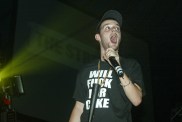In a blaze of bluesy guitars and sizzling horns, Nathaniel Rateliff & The Night Sweats have spend the last couple of years asserting their spot among the great live blues bands currently on the circuit. Their self-titled 2015 LP was a breakthrough moment for Rateliff, who had been making music in a variety of guises for over a decade prior. At long last, the singer-songwriter had a firm grip on his musical identity; as well as a troupe of exceptional musicians to anchor it to. With gold sales and sold-out theatres greeting them, the success served as a double-edged sword of sorts. After all, how do you follow up something so momentous – and, more importantly, how do you better it?
It’s for this reason that Tearing at the Seams, the second album from The Night Sweats, was not written across a single stretch. “There’s a few different timelines there,” begins Rateliff, discussing how the songs came to be. “Take ‘Intro’. That’s a song that’s been around for as long as we’ve been a band. We’ve been playing it since the early days, but we were never able to quite nail it in the studio until we came up with this version that’s finally made it onto a record. You’ve also got a song like ‘Coolin’ Out,’ which I came up with on a writing project in Los Angeles. This was before the Night Sweats had even come together. It just took me a long time to finish, for whatever reason.”
As far as a turning point for Tearing at the Seams is concerned, Rateliffe namechecks ‘Hey Mama’. While each song on the album was born of different circumstances – a jam session; a chance musical encounter – Rateliff traces the song back to a Tom Haverford-approved “treat yo’self” moment. “We were touring, and I was amazed that we were actually making money and breaking even on tour for the first time,” he says. “I felt really good, so I went out and bought myself a vintage late ’60s Gibson acoustic. I was strumming on the thing, and I was in love with it – I was like, ‘Man, everything I play on this thing comes out sounding like a fucking Rolling Stones song!’ I came up with this guitar lick, which ended up being the starting point for ‘Hey Mama’. The guts of it came together just jamming out in the greenroom with the rest of the guys.”
Tearing at the Seams was primarily recorded in Rodeo, a town near the border of Arizona on the side of New Mexico. For those unfamiliar, Rateliff describes the area as about as isolated as you can get. “We rented a ranch out there in the middle of the desert,” he says. “It’s this dark-sky community, There’s no light out there… it’s just stars, man. Jamie [Mefford], our live tech, came out and set up a studio for us out there.” The band got to work, spending about a week recording with Mefford behind the desk. It’s here that the various timelines of the quote-unquote “new” songs began to sync up, developing over the period of this first run at recording. “I had all of these ideas that I’d been working on for awhile, but I hadn’t had the chance to really get in there and hash them out,” says Rateliff. “We finished about 11 songs while we were there, and then we were back out on tour. Jamie’s on the road with us all the time, so we were able to do some extra recording while we were out on the road as well.”
Round two came when Rateliff and co. ended up at the house of Richard Swift, the man who would go on to produce Tearing at the Seams. Having previously worked with the band on their debut, Swift knew exactly how to coax the best takes and the best ideas out of them. “He wasn’t pressuring us to finish any tunes,” Rateliff says. “He was just encouraging – ‘Just go in there and play,’ he’d say. Mark [Shusterman, keys] had an idea he’d been kicking around for awhile, so we jammed on it for awhile. That ended up being ‘Shoe Boot,’ and it was another one that made it onto the album.”
With all of these songs in the can, one could safely assume that this is where the process for Tearing at the Seams comes to an end. In truth, it was only the beginning – as Rateliff discovered, the songs in any assembly weren’t quite what he was looking for. “I was really proud of the songs when we were finished – we must have done about 18 of them all up. I couldn’t shake the feeling, though, that it was just too sad. It really sounded like a divorce record, y’know what I mean? It didn’t feel like the record I wanted to make, or the one we needed to make.” It’s at this point, Rateliff decided to implement some affirmative action. “I took some time off by myself, just to sober up a bit and work on the songs.” Sadly, it was not a fruitful experiment: “I couldn’t come up with shit,” Rateliff says bluntly. “That’s when I found myself back at Richard’s.”
Working again with Swift, Rateliff came to the epiphany that although his name leads the fray of the band name and his face dawns the album cover, this band is all about the sum of its parts. The more Rateliff talks about Tearing at the Seams, the clearer it becomes that this is just as much The Night Sweats’ record as it is his. “In the past, I’ve been more insistent on doing things on my own – whether that’s writing, demoing, overcoming any obstacles I find in my songs,” he says.
“This time around, I really wanted the guys to feel as though they had some ownership and creativity in the process. Because we’ve been playing together for so long now, I really feel like we’ve become a great band. We know how to work well with one another. For me, it’s nice to let go of controlling everything all the time. There’s a lot of trust within the fold of this band – we’re all working together; we’re all on the same page.” Along with Shusterman contributing ideas and co-writing, Rateliff also points to saxophonist Jeff Dazey as someone who was instrumental in shaping what Tearing at the Seams ended up sounding like. “Jeff used to play with Leon Bridges, so he has a bit of an outside perspective on the band,” says Rateliff. “He’s from Texas, so he just calls it like he sees it. ‘Y’all cut your teeth on this r&b and soul shit,’ he said to me. ‘But you guys are a fuckin’ rock & roll band! I wanna hear some Exile [on Main Street] type shit!’” Rateliff laughs. “Alright, man – if you say so!”
By the middle of 2017, Tearing at the Seams was finally completed. This, however, saw the process come to an uncomfortable halt – due to the usual red tape that comes with major-label releases, it would be at least a year before listeners got to hear any tracks in their recorded sense. “Our fans have been wanting a new record for about two years, but obviously the business side of things means that you can’t have something out that quick,” Rateliff says. “You can maybe do a record 18 months later if you’re lucky. It’s not something we really have control over. What we do have control over, however, is playing the songs. We started doing more and more as we were on the road – we’ve been playing the same set for so long, so we were all ready for something different.”
So it was that The Night Sweats would go on to trial new songs, interspersed with their older cuts and fan favourites. The reception was so strong, that they included another. And another. And another. “By the end of the last tour, it was nearly half the set – we must have ended up doing eight new songs,” says Rateliff. “That’s most of the new record. I have to say, it’s been a lot of fun being able to play them.” Now, at long last, we’re only a matter of weeks away from hearing Tearing at the Seams in its entirety. After years of false starts and indecision, we’re finally ready to witness the next chapter in this already-intriguing career. “People have been very kind and very receptive when we’ve been playing these songs – and that’s all before any recordings have actually come out,” says Rateliff. “I’m excited for people to really get to know these songs once they’ve heard the completed versions.”
—
Nathaniel Rateliff & The Night Sweats’ new album ‘Tearing At The Seams’ is out today. Grab it here.












